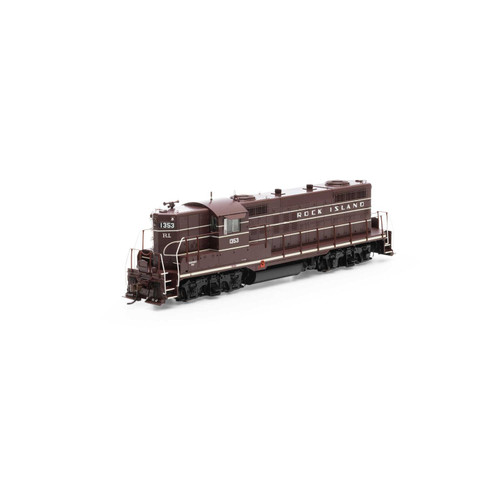RI FEATURES:
- As-delivered and one repaint version
- 5-chime horn
- Non dynamic brakes
Rock Island’s 1300-series GP18s came from EMD in 1960 (1333-1343) and 1961 (1344-1353). The units joined GP7 and GP9 examples on the road’s roster, in addition to many more uncommon early diesels that served Rock Island. From main line power used across the 14-state system in their early years to local power, the GP18s saw much use and many miles on the fabled Rock Island.
ROAD NUMBER SPECIFIC FEATURES:
#1340- As-delivered paint scheme
- Pilot mounted foot boards
- Off-white stripes to simulate early scotchlite color
- Later simple repaint
- Added V-style spark arrestors
- Small EMD plows on both ends
- As-delivered paint scheme
- Pilot mounted foot boards
- Off-white stripes to simulate early scotchlite color
GP18 SERIES LOCOMOTIVE FEATURES:
- Full cab interior
- Wire grab irons
- Coupler cut levers
- See-through cab windows
- Flexible rubber trainline hose
- Flexible rubber MU hoses
- Drop steps unless noted
- “Nub” style walkway tread
- Lift rings
- Sander lines
- Windshield wipers
- MU stands
- Bell placement & type per prototype
- Etched metal radiator intake grilles and fan grilles
- Air tanks mounted below sill unless noted
- Blomberg-B trucks with appropriate bearing caps
- Speed recorder unless noted
- Accurately-painted and –printed paint schemes
- Body-mounted McHenry® operating scale knuckle couplers
- Fully-assembled and ready-to-run
- DCC-ready features Quick Plug™ plug-and-play technology with 21-pin NEM connector
- Scaled from prototype resources including drawings, field measurements, photographs, and more
- Fine-scale Celcon handrails for scale appearance
- Detailed fuel tank with fuel fillers, fuel gauges, breather pipes, and retention tanks
- Genesis driveline with 5-pole skew wound motor, precision machined flywheels, and multi-link drivetrain
- All-wheel drive with precision gears for smooth & quiet operation
- All-wheel electrical pickup provides reliable current flow
- Wheels with RP25 contours operate on all popular brands of track
- Bidirectional constant LED lighting so headlight brightness remains constant
- Heavy die-cast frame for greater traction and more pulling power
- Packaging securely holds model for safe storage
- Minimum radius: 18” — Recommended radius: 22”
PRIMED FOR GRIME MODELS FEATURE
- Duplicated look and feel of “In Service” equipment
- Faded base colors matched to the prototype
- Perfect starting point for adding grime and rust
SOUND-EQUPPED MODELS ALSO FEATURE
- Onboard DCC decoder with SoundTraxx Tsunami2 sound
- Dual cube speakers for optimal sound quality
- Sound units operate in both DC and DCC
- Full DCC functions available when operated in DCC mode
- Engine, horn, and bell sounds work in DC
- All functions NMRA compatible in DCC mode
- Precision slow speed control
PROTOTYPE SPECIFIC INFORMATION
The EMD GP18 began production in late 1959 and was based on the builder’s extraordinarily successful GP9, although the latter model was still in production at the time. The GP18 is considered the last of the builder’s “first generation” models. Similar in appearance to the GP7 and GP9, the GP18 was slightly more powerful and came with the option of a low or high short cab hood, something that had only been upon special request with EMD’s first two road switcher models. It used the final version of General Motors first locomotive prime mover, the 16-cylinder model 567D1 which could produce 1,800 horsepower, the most powerful in the series up to that time. At just over 56 feet in length the GP18 was the same length as its predecessor models and was visually very similar, with the exception of new radiator grills which were also used on the GP20.
While thousands of GP7s and GP9s were produced just a few hundred GP18s were ultimately built for a little more than two dozen railroads. Today, several GP18s remain in operation on numerous short lines and industrial operations around the country.







